Cognition in mouse models of schizophrenia susceptibility genes
- PMID: 20026558
- PMCID: PMC2833129
- DOI: 10.1093/schbul/sbp153
Cognition in mouse models of schizophrenia susceptibility genes
Abstract
Cognitive deficits are core features of psychiatric disorders and contribute substantially to functional outcome. It is still unclear, however, how cognitive deficits are related to underlying genetic liability and overt clinical symptoms. Fortunately, animal models of susceptibility genes can illuminate how the products of disease-associated genetic variants affect brain function and ultimately alter behavior. Using as a reference findings from the Cognitive Neuroscience Treatment Research to Improve Cognition in Schizophrenia program and the SchizophreniaGene database, we review cognitive data from mutant models of rare and common genetic variants associated with schizophrenia.
Figures


References
-
- Hagan JJ, Jones DN. Predicting drug efficacy for cognitive deficits in schizophrenia. Schizophr Bull. 2005;31:830–853. - PubMed
-
- Green MF, et al. Approaching a consensus cognitive battery for clinical trials in schizophrenia: the NIMH-MATRICS conference to select cognitive domains and test criteria. Biol Psychiatry. 2004;56:301–307. - PubMed
-
- Cohen JD, Insel TR. Cognitive neuroscience and schizophrenia: translational research in need of a translator. Biol Psychiatry. 2008;64:2–3. - PubMed
Publication types
MeSH terms
Substances
Grants and funding
LinkOut - more resources
Full Text Sources
Medical

